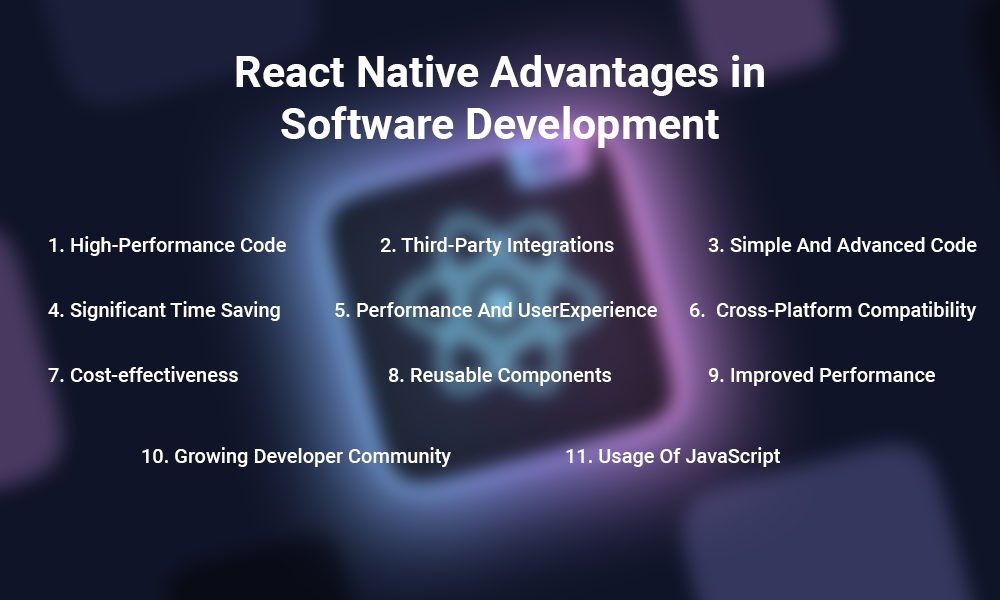React Native is an open-source mobile application framework that Facebook developed that enables programmers to create high-performance mobile applications for the Android and iOS platforms. It gives developers access to a graphical user interface with a selection of components such as containers, texts, photos, or lists by fusing the strength of React with native platform features. When nested inside one another, all of these components make up an application’s various facets.
Software Development Using React Native
The only difference between React Native and React is that React Native doesn’t change the DOM using a virtual DOM. Instead, it executes as a background process on the client system, understands JavaScript code written by developers, and uses serialized data for asynchronous bridges and batch communications with the origin platform.
React Native is a framework worth investigating if you’re interested in software development, particularly in developing mobile applications. With React Native, you can build cross-platform mobile applications that work on iOS and Android devices from a single codebase. The framework comes with a wide range of components and tools that can speed up your development procedure and enhance the functionality of your apps.
The Top 10 React Native Components for Software Development are listed below so you can maximize the most of your software development efforts. By leveraging these components, you may create strong and effective mobile applications that satisfy your business goals and provide a seamless user experience.
Best React Native Components For Software Development
You should include a few key components when creating an app with React Native. These components will not only assist you in building an enticing and helpful app, but they will also help you develop it faster and more efficiently. Let’s examine these components and how they might help your software development project.
1. React Native Elements
A cross-platform interface tool called React Native Elements combines various open-source user interface elements in specific locations. These elements have unique features that developers can change at runtime without reloading the application. This is extremely beneficial because it enables programmers to concentrate on the app’s functionality and create attractive applications with a unique aesthetic. React Native Elements also includes generic UI elements for the overall user experience and application design.
2. React Native Vector Icons
It’s simple to customize, design, and integrate React Native Vector Icons into your application development. They enable you to locate particular substances that meet your requirements. A very intuitive design, quicker icon import, and easy expansion, design, and integration are all advantages of using the vector icon component.
The following are some benefits of the Vector Icons Component:
- It is well-known for developing nav/tab bars, buttons, and logos.
- You can import icons more quickly if you use vector icons.
- They are easy to update, extend, and integrate into your apps.
3. React Native Material Kit
The application template for React Native Material Kit is completely developed, allowing software engineers to create applications rapidly and effectively. Over 200 component variables, including input, navigation, buttons, maps, and more, are available for developers to choose and combine freely. Theme files’ color variations are simple to manage and modify.
React Native Material Kit’s advantages include:
- Expo.io for iOS and Android
- Google Material Design
- Open-Source Fonts
- Documentation
4. React NativePaper
React Native Paper is a set of customizable, ready-to-use components to develop React Native mobile applications. You can customize the functionality with this component. Theme support is also useful when transitioning between light and dark settings.
The benefits of React Native Paper are as follows:
- It is a top-notch Material Design standard-compliant library.
- Additionally, it covers every significant app development use case.
- React Native Paper is readily available and free to download.
- On both platforms, it performs consistently, has a quick UI, and is responsive.
5. React Native Ignite
Because it unifies the concepts of styles, layouts, and stacks from Infinite Red in one place, React Native Ignite is a well-liked approach that is excellent for software development. An immense amount of development time is saved by this tool. Additionally, it includes support for AsyncStorage, fin, MobX-React-Lite, MobX-State-Tree, TypeScript, and Reactive Navigation 5.

6. React Native Base
With the aid of the utility library React Native Base, engineers can create a single design system that works on iOS, Android, and the web. If you hire React app Developers, they can personalize the look and feel of their app’s themes and components using the theming tools included in the React Native Base elements. ARIA provides app developers with rapid access to many React Hooks for designing systems. You can alter how your application behaves on various platforms with NativeBase.
Below are some of NativeBase benefits:
1. Naturally Beautiful – Native Base creates a naturally beautiful app with attractive components.
2. Multi-Platform – It is simple to develop and supports an array of platforms. Utilizing platform-specific mounts, you can request that developers change an app’s attributes.
3. Accessible – NativeBase delivers the box effect, focus management, and keyboard navigation and is easy to access and utilize.
4. Customizable – It is a default theme that may be modified to add components to the app according to the requirements of that particular app.
7. React Native Bit
The components used in React Native Bit tools are designed to help you write software more quickly. With the help of this extensible system toolkit, professionals may more easily understand, test, maintain, and work together on software development projects. Bit components let programmers create components independent of their apps and use them to create various applications. Additionally, programmers can modify an application’s component’s functionality.
8. React Native Debugger
Developers can inspect and debug React Native projects using the Chrome Developer Tools interface using the desktop application React Native Debugger. It offers potent debugging and performance profiling tools for React Native projects, including network, Redux architecture, and performance debugging.
9. React Native Image Picker
Popular library React Native Image Picker makes it simple to choose photos from the device’s camera roll or capture brand-new pictures using the device’s camera. It is often used in mobile applications like social media and e-commerce apps that ask users to upload or edit photographs.
10. NativeWind
NativeWind is a framework that uses Tailwind CSS’s strengths as a scripting language to develop a universal style system for React Native. NativeWind enables developers to build styles with a utility-first approach by implementing Tailwind CSS, making it effective and simple to maintain styles across many components and screens. The ability to share elements between platforms is one of NativeWind’s main benefits. As a result, you can utilize NativeWind to design UI components and use them seamlessly in projects for both Android and iOS, thereby cutting down on development time and maintaining consistency in the user experience between platforms.
What Are React Native Advantages in Software Development?
1. High-Performance Code That Is Shared And Reusable
Much of the code can be shared between iOS and Android apps because of React Native, which speeds up the development and maintenance processes. When native components are used, and a dedicated thread is used for the most resource-intensive operations, React Native applications perform similarly to native ones. Additionally, you may reuse the existing code of your React web applications and convert it into mobile applications using React Native.
2. Third-Party Integrations
Integration with third-party platforms is crucial for a startup. Many additional capabilities can be integrated to accelerate program development. Many are already included in React Native, making it a reliable and effective development environment.
3. Simple And Advanced Code
JavaScript, the core language of React Native, is not as complex as other programming languages. It already has a significant development community and is widely used on the development of the web app. Less redundant code results in shorter strings of code and a shorter overall file size, ultimately resulting in faster product development and release to market times.
4. Significant Time Saving
When a developer creates a web application, all he needs to do to see the changes is to keep the modifications and reload the browser. It is different for a native application because it requires recompiling every time, even if only a text or pixel change has occurred.
With React Native, developers can instantaneously reload an application rather than having to recompile it. By emphasizing the truly important information, developers can save time.
5. Performance And User Experience
Applications created using React Native give a similar experience to those created natively and generated by the platform, unlike solutions based on straightforward embedded WebViews. Also, elements are delivered to the screen. This provides faster loading times and a natural grip.
6. Cross-Platform Compatibility
Businesses can create applications for iOS and Android using the same code with the help of React Native. On both platforms, developers can obtain precise performance results without incurring additional money. A startup must only be concerned about finding developers who can use the React Native platform’s advantages.
7. Cost-effectiveness
Unlike on-premise approaches, a single code base offers the chance to reduce development time and costs drastically. React Native is thus less expensive. Additionally, it guarantees consistent user interfaces across all platforms, functional code, and the full product life cycle. React Native includes a hot reload feature as part of its development. By enabling developers to observe the effects of their changes without recompiling the entire source code, this saves them time.
8. Reusable Components
Platform developers frequently use a variety of components to enhance the functionality of native components while developing hybrid apps. To deliver native-like mobile experiences and satisfy all necessary functionalities, React Native offers components for both Android and their native iOS counterparts, which may also be used as reusable components.
9. Improved Performance
React Native, in contrast to other frameworks, enables the development of high-performance native mobile apps. It gives a pleasant user experience and interface (UX and UI) and is adaptable and responsive. Without using a web browser, connect your Javascript code to the native components of your device. Therefore, there has been no performance compromise. At the interface level, it also responds well.
10. A Growing Developer Community
React Native has an active developer community routinely contributes to its development and shares knowledge on online forums, offering developers efficient support. The framework’s community is constantly expanding because it is open source and updated regularly by Meta. Additionally, React Native enables you to view changes made to your app in real time without having a reboot.
11. The Usage Of JavaScript
The first of its unique features is that this framework enables the development of native mobile apps for iOS and Android that use the React concept and design.
Conclusion
To sum up, React Native is a powerful mobile software development platform that may assist you in developing stunning and useful apps for iOS and Android devices. The components we covered above are just a few of the numerous choices available to developers, and each one offers special advantages and capabilities that boost the process of developing apps. These components will undoubtedly simplify your work and improve your projects’ functionality and aesthetic appeal, whether you’re an experienced developer or just getting started with React Native.
Bosc Tech Labs is the best choice if you’re seeking a reliable and experienced development partner to assist you in creating your React Native application. Our team of experts can assist you in bringing your app idea to life and deliver a high-quality solution that satisfies all your business demands. We have a team of talented developers and a track record of success. Please don’t put it off any longer; contact us immediately to start developing your dream app!
Frequently Asked Questions (FAQs)
1. Which React Native component library is the most widely used?
A well-liked library for React Native mobile app development is React Native Paper. It gives developers access to various components, including buttons, cards, lists, etc. In addition, it offers developers multiple options for customizing their applications’ appearance and feel.
2. What are the components of React Native?
The user interface of mobile applications is built using React Native building blocks. You can combine them to make the app’s interface and functionality. They contain UI components like Text, View, Buttons, and more.
3. Does cross-platform compatibility exist for React Native components?
Yes, React Native components are designed to work across platforms. This implies that UI elements for iOS and Android platforms can be built using the same features.





